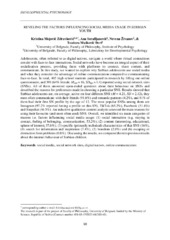Приказ основних података о документу
Reveling the factors influencing social media usage in Serbian youth
| dc.creator | Mojović Zdravković, Kristina | |
| dc.creator | Serafijanović, Ana | |
| dc.creator | Živanov, Nevena | |
| dc.creator | Mašković-Đeri, Teodora | |
| dc.date.accessioned | 2024-03-26T12:59:17Z | |
| dc.date.available | 2024-03-26T12:59:17Z | |
| dc.date.issued | 2024 | |
| dc.identifier.isbn | 978-86-6427-284-1 | |
| dc.identifier.uri | http://reff.f.bg.ac.rs/handle/123456789/6334 | |
| dc.description.abstract | Adolescents, often referred to as digital natives, navigate a world where virtual connections coexist with face-to-face interactions. Social networks have become an integral aspect of their socialization process, providing them with platforms to connect, share content, and communicate. In this study, we wanted to explore why Serbian adolescents use social media and what they consider the advantage of online communication compared to communicating face-to-face. In total, 405 high-school students participated in research by filling out online questionnaire, and 391 (64% female, Mage = 16, SDage = 1.4) reported using social network sites (SNSs). All of them answered open-ended questions about their behaviour on SNSs and described the reasons for preferences made in choosing a particular SNS. Results showed that Serbian adolescents are, on average, active on four different SNS (M = 4.21, SD = 2.12), they most often communicate with their friends (91.6%) and romantic partners (4.2%), and 81% of them had their first SN profile by the age of 12. The most popular SNSs among them are Instagram (97.2% reported having a profile on this SN), TikTok (65.2%), Facebook (51.4%) and Snapchat (46.5%). An inductive qualitative content analysis assessed the main reasons for using their favourite (and most often used) SNS. Overall, we identified six main categories of reasons i.e. factors influencing social media usage: (1) social interaction (e.g. staying in contact, feeling of belonging, communication; 53.2%); (2) content (interesting, educational, sphere of interest; 37.6%); (3) specific (primarily technical) characteristics of that SNS (16%), (4) search for information and inspiration (7.4%), (5) boredom (2.8%) and (6) escaping or distraction from problems (0.8%). Discussing the results, we compared them to previous results about the internet behaviour of Serbian children. | sr |
| dc.language.iso | en | sr |
| dc.rights | openAccess | sr |
| dc.rights.uri | https://creativecommons.org/licenses/by/4.0/ | |
| dc.source | Book of Abstracts, XXX Empirical Studies in Psychology, Belgrade, Republic of Serbia | sr |
| dc.subject | social media | sr |
| dc.subject | social network sites | sr |
| dc.subject | digital natives | sr |
| dc.subject | online communication | sr |
| dc.title | Reveling the factors influencing social media usage in Serbian youth | sr |
| dc.type | conferenceObject | sr |
| dc.rights.license | BY | sr |
| dc.citation.spage | 80 | |
| dc.identifier.fulltext | http://reff.f.bg.ac.rs/bitstream/id/16252/bitstream_16252.pdf | |
| dc.identifier.rcub | https://hdl.handle.net/21.15107/rcub_reff_6334 | |
| dc.type.version | publishedVersion | sr |

